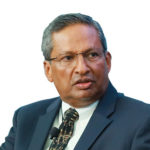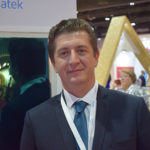Nearly zero-energy buildings are not just a global reality but rather are being recognised as being the need of the hour to reduce the use of energy, says Benwen Lopez, as he looks into the nZEB framework in the GCC region.
Nearly zero-energy building (nZEB), as a terminology, has steadily gained ground in the global lexicon. In a nutshell, a nearly zero- energy building is a structure that is equipped with multiple energy-efficiency measures to gradually reduce its reliance on non- renewable energy, over a period of time.
Achieving nZEB is a goal, and there are multiple factors that contribute towards reaching the milestone, including a range of technological measures to simple lifestyle practices. The big question, though, is, ‘What progress has the GCC region made towards establishing nZEBs in the firmament?’
Defining nZeB

Mario Seneviratne
The road to achieving nZEB in the GCC region is not an easy path, and indeed there are no shortcuts. As Mario Seneviratne, Director, Green Technologies, puts it: “Achieving nZEBs is a market transformation journey. It is not something that can be achieved from an intensely high-energy utilisation to an extremely low- energy utilisation; it needs to be achieved gradually through the mitigation of the environmental impact of the energy used.”

Roger Woodward
Voicing a similar view, Roger Woodward, Vice President and Managing Director, EMEA region, Tridium, says that the true pathway to a nZEB is the gradual reduction of energy to the single digits and, eventually, to zero. “The goal of achieving nZEBs provides a huge opportunity for every person to join in the energy mitigation movement, and this will happen only over time through a long-lasting awareness campaign,” he says.
The challenges

Charles Blaschke
Industry insiders contend that three key challenges to achieving an nZEB are a change in the end-user mind-set, with the remaining two being technical and financial in nature. However, of the three, the challenge relating to changing the mind-set of the end-user is most formidable. As Charles Blaschke, Managing Director, Taka Solutions, says: “Most people are very short-term minded. They do not look forward to living an energy-sustainable life. If this attitude is transformed, the pace towards achieving nZEBs in the GCC region will accelerate.”
Further explaining his contention, he says, while one may use the latest MEP systems, engineering design and architecture to develop an nZEB, the building operations aspect is most crucial, which is a joint effort by facility managers and occupants, and that is missing in most buildings in the UAE. “We cannot rely solely on the facility managers,” he says. “The onus also lies on the building occupants to ensure that the goal is achieved. Therefore, you need occupants, who care enough and are made aware of how to live an energy-sustainable life.”
Apart from the end-users, an increased awareness of quality engineering would contribute to the change in mind-set, believes Chris Irvin, Vice- President of Sales, EMEA, Distech Controls. He says: “In this part of the world, the culture of contracting and procurement seems to be focused on paying the lowest possible price for a system. And if one installs a cheap system, the long-term costs will be much more than the capital cost, which includes the impact on energy.”

Saeed Al Abbar
Elaborating on the lack of awareness of utilising energy-efficient systems, Saeed Al Abbar, Chairman, Emirates Green Building Council, adds: “There is a misperception that higher investment costs are required for the construction of energy-efficient buildings compared to the conventional ones. While there may be a higher initial capex, it is balanced by a much lower opex of the building.
“The energy savings achieved over the lifetime of the building usually exceed the capex within the first few years, and it has been proven that energy-efficient buildings, with up to 90% less primary energy for cooling, can be constructed cost effectively in most parts of the world.”
Mirroring Al Abbar’s views, Woodward believes that though the capex is a challenge, there is a return on investment. “I believe that building owners will look at the capital costs as an obstacle, but they also need to realise that it is counterpoised by the operational costs, thus generating the return on investment over the years,” he says.
Grassroots Awareness
Considering that achieving nZEB would take a significant period, Kheira Anissa, Professor for the Department of Architectural Engineering, United Arab Emirates University (UAEU), believes that the gap of awareness for nZEBs can be countered at the academic level. She says: “Energy-sustainable lifestyles need to be grounded from the academic level. In my experience, I notice that students are excited and shocked with the impact they make on the environment with their lifestyles. When they get a first-hand experience, they can connect the dots and transform their lives. However, this requires a lot of effort.”
Anissa further believes that through collaboration with industry experts, students will be more equipped to understand the principles of such initiatives and achieve the nZEB target in the region.
Available Technologies

Spiros Chirstaras
It is a given fact that nZEB cannot be achieved without the adoption of technologies. Explaining the types of solutions, Spiros Chirstaras, Business Development, Heliatek, says: “In Dubai, we can see beautiful buildings with glass façades, and these elements of the design contribute immensely to the cooling load. The simple solution would be to install sustainable building façades, which are fitted with a solar film, eventually reducing the load on the cooling and making the façade sustainable.” The solar film-laminated facades, he says, work as thermal insulation and reduce the load on cooling and lighting.

Dr Chin Huai Young
Speaking on the use of solar film to reduce energy, Dr Chin-Huai Young, Chief Technical Officer, Taiwan HISG Corp, says, “One of the contributing factors to the nZEB goal is the use of heat insulation solar glass, which can act as an insulation and as a power generator.”
Explaining the characteristics, Dr Young says the core of the technology is based on the theory of off-module solar power enhancement, and it increases the heat insulation ability. It consists of see-through multi-junction thin film to generate high solar power, and the reflection feature of the thin film is to reduce the heat penetration. The electricity generated is enough to run the building and also feed it back into the grid.
 The other technologies available to achieve nZEB are disruptive solutions, believes Hanan Darwish, President (Gulf and Pakistan), Schneider Electric. She says: “One of the main stakeholders is the facilities management, and we are offering the eco-structure model for them [FM personnel] to take advantage of and have a better control of the building, during operation and maintenance procedures.”
The other technologies available to achieve nZEB are disruptive solutions, believes Hanan Darwish, President (Gulf and Pakistan), Schneider Electric. She says: “One of the main stakeholders is the facilities management, and we are offering the eco-structure model for them [FM personnel] to take advantage of and have a better control of the building, during operation and maintenance procedures.”
The motivating factors
Any initiative requires a motivating factor, but in the case of nZEb, it is an urgent need for the region, and one that would also align with the energy strategies, chartered out by the UAE, say.
Explaining the importance of the initiative for the UAE, Al Abbar says, “nZEBs are an essential measure to support the UAE’s pledge to combat global warming at COP21 in 2015 and its ratification of the Paris Agreement in 2016 as well as the sustainable development goals outlined by the UAE Vision 2021, Abu Dhabi Plan 2030 and Dubai Plan 2021.”
Sharing a similar opinion, Blaschke says: “nZEB is vitally important, because the resources in the world are limited and it is only a matter of time for those resources to become extinct. Hence, we need to treat nZEB as a priority.”
Target deadline
To achieve any initiative, a deadline must be set. In the drive towards reducing energy use, deadlines have been set. On the same basis, Al Abbar, says, “According to the survey conducted as part of Emirates GBC’s ‘Defining nZEB in the UAE’ report, the majority of the respondents agreed that the UAE market is ready for an nZEB strategy and indicated an implementation timeline of 2020 or 2030.
“In fact, the responses were very close to international targets set in the United States, Australia and in particular EU Member States, whereby a general timeline of 2020-2030 has been set for adoption of the nZEB concept.”
However, stakeholders like Woodward believe that such deadline targets are debatable. He says: “If we look at Germany, there are many old buildings. I wonder if such deadlines are achievable, unless done in phases.” However, he adds, “The positive attitude of the UAE Government would boost the efforts to achieve nZEB, and such an attitude is required all over the world to achieve such a goal.”
Concurring with Woodward, Seneviratne says: “If the UAE can build the largest man-made port in the world or the tallest building in the world, then nZEB is achievable.”
Plethora of Opportunities
Stakeholders believe that the nZEB strategy, by itself, presents opportunities for the HVACR industry. From the construction perspective, Blaschke says, the retrofit opportunities are the big game-changer. He adds: “In Dubai alone, we have a significant stock of old buildings, which are craving for an upgrade, and experts can step in and perform retrofit projects. However, it is the mind-set of the owners that have to change; [they have to] be open to pushing the envelope towards achieving nZEB.”
Moving Ahead
While achieving nZEBs is critical for the GCC region, Al Abbar says they can be viewed as a stepping stone to reaching net-zero-energy buildings. “For net-zero to be achieved, both newly constructed buildings and existing building stock should also be built to nZEB principles,” he says.
In the case of achieving net-zero from nearly zero-energy, it requires a strong determination from building owners. Explaining the results of a strong conviction, Seneviratne says, “Net-zero can be achieved when the property owner is passionate to make it happen.”
Sharing details of a project his company worked on in Saudi Arabia, Seneviratne adds: “When we were working on the SABIC Home of Innovation in Saudi, the owner of the project was determined to achieve nZEB and made no compromise whatsoever. The best teams were hired, the best materials were used, weekly and monthly inspections were carried out, and today the building records net zero, owing to the strong determination of the owner.”
Lifestyle practices
Lifestyle practices, like implementing energy-saving measures in the office or home, can help achieve the nZEB goal, believes Seneviratne. While sharing his thoughts on nZEB, an alarm goes off, and smilingly he points out that it is the tabletop CO2 device that indicated the CO2 levels of the office had gone up, and the air conditioning needs to be switched on. He further says that buildings today need to be designed as staircase friendly, and people need to be motivated to climb at least two floors, if possible, as elevators consume vast amounts of energy. He further adds that in his office, the air conditioning system starts to turn off an hour before the shift ends, so that it eventually shuts off. Such practices have helped his company achieve an eco-award from the Dubai Airport Free Zone Authority, where his office is located, he says.
Seneviratne argues that while it is a general perception that nZEB is only about innovation it is about conservation, and one should be self- disciplined to turn off appliances, when not needed, to conserve energy. He further adds that when chillers and other appliances need to be installed, the energy penalty must always be questioned and, perhaps, introspected, whether an equipment with a lesser penalty can be installed.
Agreeing with Seneviratne’s views, Irvin adds that enabling the optimum stop of chillers in a building, especially when all the occupants of the building are about to exit, would significantly contribute towards achieving nZEB.
Sharing another technique, he says, night-time purging is another way one can cool the building, using the cold air at night. “It is a simple technique of utilising free cooling from the cold atmosphere during winter and running it through the building so that during the day, you do not have to switch on the chillers early.”
Springing ahead
Like other initiatives, nZEB fits into the larger picture of the UAE map towards realising energy self-sufficiency. However, as many stakeholders argue, while nZEB is achievable, it takes a change in mind-set to achieve the target by the deadline. And as Seneviratne says, it is not about innovation but about energy conservation and self-discipline. Therefore, the question we need to ask ourselves is whether we are ready and willing to transform our buildings into nZEBs or not?
Copyright © 2006-2025 - CPI Industry. All rights reserved.